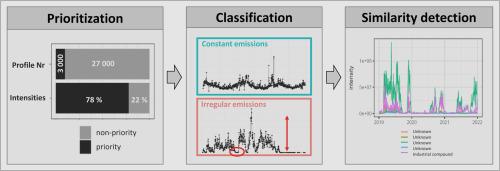当前位置:
X-MOL 学术
›
Water Res.
›
论文详情
Our official English website, www.x-mol.net, welcomes your
feedback! (Note: you will need to create a separate account there.)
Unveiling industrial emissions in a large European river: Insights from data mining of high-frequency measurements
Water Research ( IF 11.4 ) Pub Date : 2024-11-03 , DOI: 10.1016/j.watres.2024.122745 Teofana Chonova, Steffen Ruppe, Ingrid Langlois, Dorrit S. Griesshaber, Martin Loos, Mark Honti, Kathrin Fenner, Heinz Singer
Water Research ( IF 11.4 ) Pub Date : 2024-11-03 , DOI: 10.1016/j.watres.2024.122745 Teofana Chonova, Steffen Ruppe, Ingrid Langlois, Dorrit S. Griesshaber, Martin Loos, Mark Honti, Kathrin Fenner, Heinz Singer

|
Despite the tremendous efforts to improve river water quality, chemical contamination remains a significant issue. Besides well-known contaminants, in recent years, pollutants of industrial origin received increasing attention because of the huge knowledge gap regarding their occurrence, fate and environmental risks. Moreover, such pollutants often exhibit high concentration fluctuations over time, which makes them less predictable and measurable with classical short-time campaigns.This study provides insights into the different sources of chemical contamination of the Rhine River based on temporal high-frequency LC-HRMS monitoring data from a single location. A newly developed prioritization strategy selected nearly 3000 substances as potentially major contaminants. A novel classification analysis based on temporal behavior identified 53% of these compounds (accounting for 62% of the time-integrated intensity recorded in the dataset) as originating from irregular emission sources. Irregular emissions can originate from industrial production cycles. After delimiting other potential irregular sources, we have strong evidence indicating that a considerable share of the irregular emissions likely comes from industrial activities. This finding is supported by the structural elucidation of sixteen irregularly emitted substances, for which the industrial origin was successfully confirmed. Those compounds include 3-chloro-5-(trifluoromethyl)pyridine-2-carboxylic acid and 4-(dimethylamino)-2,2-diphenylpentanenitrile. In addition, 40 other compounds exhibited temporal emission patterns similar to the sixteen industrial compounds, which strongly suggests a common contamination source. Finally, 100 top-ranking compounds were selected for further structural elucidation and emission reduction measures. The computational approach outlined within this study can be effectively applied in other large river catchments to identify unknown contaminants stemming from industrial sources.
中文翻译:

揭示欧洲一条大型河流的工业排放:来自高频测量数据挖掘的见解
尽管为改善河流水质做出了巨大努力,但化学污染仍然是一个重大问题。除了众所周知的污染物外,近年来,由于对其发生、归宿和环境风险存在巨大的知识差距,工业来源的污染物也越来越受到关注。此外,此类污染物通常随时间表现出较高的浓度波动,这使得它们在经典的短时活动中难以预测和测量。本研究基于来自单个位置的时间高频 LC-HRMS 监测数据,深入了解莱茵河化学污染的不同来源。新制定的优先排序策略选择了近 3000 种物质作为潜在的主要污染物。一项基于时间行为的新型分类分析确定了这些化合物中的 53%(占数据集中记录的时间积分强度的 62%)来自不规则的发射源。不规则排放可能来自工业生产周期。在划定了其他潜在的不规则排放源之后,我们有强有力的证据表明,相当大一部分不规则排放可能来自工业活动。这一发现得到了 16 种不规则发射物质的结构解析的支持,这些物质的工业来源被成功证实。这些化合物包括 3-氯-5-(三氟甲基)吡啶-2-羧酸和 4-(二甲氨基)-2,2-二苯基戊腈。此外,其他 40 种化合物表现出与 16 种工业化合物相似的时间发射模式,这强烈表明存在共同的污染源。 最后,选择了 100 种排名靠前的化合物进行进一步的结构解析和减排措施。本研究中概述的计算方法可以有效地应用于其他大型河流集水区,以识别来自工业来源的未知污染物。
更新日期:2024-11-04
中文翻译:

揭示欧洲一条大型河流的工业排放:来自高频测量数据挖掘的见解
尽管为改善河流水质做出了巨大努力,但化学污染仍然是一个重大问题。除了众所周知的污染物外,近年来,由于对其发生、归宿和环境风险存在巨大的知识差距,工业来源的污染物也越来越受到关注。此外,此类污染物通常随时间表现出较高的浓度波动,这使得它们在经典的短时活动中难以预测和测量。本研究基于来自单个位置的时间高频 LC-HRMS 监测数据,深入了解莱茵河化学污染的不同来源。新制定的优先排序策略选择了近 3000 种物质作为潜在的主要污染物。一项基于时间行为的新型分类分析确定了这些化合物中的 53%(占数据集中记录的时间积分强度的 62%)来自不规则的发射源。不规则排放可能来自工业生产周期。在划定了其他潜在的不规则排放源之后,我们有强有力的证据表明,相当大一部分不规则排放可能来自工业活动。这一发现得到了 16 种不规则发射物质的结构解析的支持,这些物质的工业来源被成功证实。这些化合物包括 3-氯-5-(三氟甲基)吡啶-2-羧酸和 4-(二甲氨基)-2,2-二苯基戊腈。此外,其他 40 种化合物表现出与 16 种工业化合物相似的时间发射模式,这强烈表明存在共同的污染源。 最后,选择了 100 种排名靠前的化合物进行进一步的结构解析和减排措施。本研究中概述的计算方法可以有效地应用于其他大型河流集水区,以识别来自工业来源的未知污染物。


















































 京公网安备 11010802027423号
京公网安备 11010802027423号